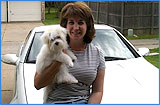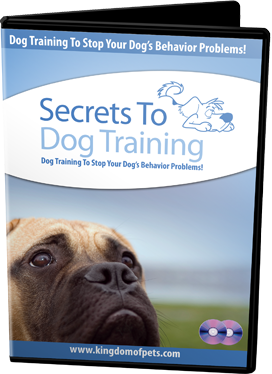If you are looking for the greatest gold-mine of easy to use "change your dog's behavior" advice ever crammed into a newsletter series then read on!
Also, make sure that you check out our 100% authentic testimonials from people who have bought Secrets to Dog Training and find out the massive difference it has made to their owner-dog relationship!
 "I highly recommend this book to all pet owners. Dogs are so trainable but can get confused if you try too many different methods out on them. Reading how to do it and do it right the first time is the way to go! I taught mine to fetch and sit by the time he was 12 weeks old."
"I highly recommend this book to all pet owners. Dogs are so trainable but can get confused if you try too many different methods out on them. Reading how to do it and do it right the first time is the way to go! I taught mine to fetch and sit by the time he was 12 weeks old."
-- Dee & Nickey (USA)
Hi Daniel,
Six weeks ago I adopted a 9 month old Beagle named Sadie. We have bonded well and she is doing very well, except for one thing....... can a dog become obsessed with a ball?
She loves to play fetch! Which is fine for about 15 minutes or so at a time, but that's all she wants to do (except for our walks together). There are times that I simply cannot play ball with her and she becomes VERY annoying and insistent.
She has an interesting variety of dog toys, but won't play with anything but this one particular ball. Do you have any suggestions?
Thank you,
Carole
Hi Carole What an interesting problem you have! I don't know how big a problem you see this as, but there are a few things that you can do to reduce her reliance on the ball.
You could remove the ball from her toys altogether. Perhaps only bring it out once you are in a park or out for a walk. Even though beagles have a great sense of smell, hiding the ball in a bag should help to reduce her distraction level.
If you want to get serious about removing her obsession with the ball then you could de-sensitize her to it with progressive training.
The progression below is a useful one that many people have used to get better results from their dogs. The first step is to have your training session in an environment where your dog is comfortable and not enticed by anything other than your commands. You can decide where you start on the progression if you feel that you would get a good response out of the earlier progressions and do not need to do it again.
You will also be the best judge of when you should move on to the next progression, but I would recommend that you move on when your dog completes a 5 to 10 minute sit-stay and a 5-10 minute down-stay. This may require you to go back to the beginning to quite basic commands but you are better to take things slowly and complete this program over a number of weeks.
1. inside, on-leash, with no ball present,
2. outside, on-leash, with no ball present,
3. outside, off-leash, with no ball present,
4. outside, on-leash, gradually introducing the ball to the vicinity,
5. outside, off-leash, gradually introducing the ball to the vicinity.
This last program is probably quite sophisticted for the level of the problem, nevertheless it is should work well if it continues to be a problem. Please let me know how you get on!
Kind regards,
![]()
Daniel Stevens and the Secrets to Dog Training Team
"Secrets to Dog Training - STOP Dog Behavior Problems!"
Daniel,
Thank you for your response. I did begin restricting ball play to outdoors only and he has finally accepted that she has to drop the ball outside the door when we go back in the house. It was very tough for a while.........she kept moping and sat at the door inside for long periods of time!
The only problem I have now is distinguishing between her need to go out to relieve herself or her "need" to play ball! I slowly began introducing new toys but the ball remains her favorite!
Thanks!
Carole
 I've been a professional dog trainer for well over 20 years, and in that time I've helped thousands of dog owners just like you to get the friendly, well behaved, slipper fetching, best pal they always wanted.
I've been a professional dog trainer for well over 20 years, and in that time I've helped thousands of dog owners just like you to get the friendly, well behaved, slipper fetching, best pal they always wanted.
But it didn't start out that way. I've always loved dogs, some things never change. But when I first started my professional dog training career I relied on the so-called 'best practices' when it came to dog behavior training. It was only when I heard people tell me over and over again that they just weren't seeing results that I started to question the old accepted wisdom. So I started a journey, a quest to search out the best, most effective, techniques, tips, and tricks that really work.
And that's how I came up with Secrets to Dog Training. Year after year I found new techniques that achieved the results I wanted. Eventually I had a whole book worth of great resources: Secrets to Dog training...
So, if you want to:
Then Secrets to Dog Training is just what you've been looking for!
Previous Newsletters
| 01 | 02 | 03 | 04 | 05 | 06 | 07 | 08 | 09 | 10 | 11 | 12 | 13 | 14 | 15 | 16 |